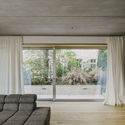
-
Architects: Barkow Leibinger
- Area: 870 m²
- Year: 2016
-
Photographs:Simon Menges, Laurian Ghinitoiu , Christina Möller
-
Manufacturers: ASSMANN & KLASEN, Bricks, GOLEM, Metal Works

Text description provided by the architects. Tucked away in the inner courtyard of a block in Berlin’s Prenzlauer Berg neighborhood, an unusual residential house has emerged: With it’s steep roof looming some 10 meters above the building — more pyramid than cube — this boldly shaped building is entirely enveloped by a multi-colored brick skin. Irregularly proportioned aluminum-frame windows reference the history of these inner courtyards, often given over to industrial use in this area of the city at the time of the district’s initial development. At first glance, the appearance of the house does not seem to adhere to popular current conceptions of context-driven building expansions. In fact, it is the end result of tight parameters stemming from building regulations and historic preservation conditions. Used creatively as design tools, these restrictions led to a building that seems at the same time both familiar and strange, capable of blending into its surroundings while maintaining a strong independent character.



Within a framework of re-densification, two initially conflicting positions needed mediating: the historic preservation office, involved due to the existing heritage protection of the building block ensemble, stipulated that the new building follow the cubature of the initial structure that had been destroyed during the war, in effect reconstructing the original configuration. But the city’s building department rejected this due to current setback regulations. The solution was to create a steeply sloped roof with an eave height of only around 7.50 m. With a slope of just under 70°, the roof stretches over three stories up to the building’s upper edge, standing at a height of approx. 18 m, where a roof terrace seems to clip the pyramid’s peak. The resulting volume, resembling the archetypal shape of a house in a child’s drawing, satisfied the prescribed distance requirements between the building and the three neighboring plots. Just like its predecessor, the almost square-shaped structure stands with its back flush to the firewall of the rear building of the abutting courtyard. A shadow gap, widening significantly from the eaves upwards, underlines the independent nature of the new building.



A brick skin seamlessly covers the cubed volume produced via these limitations — from the vertical exterior walls, over the sloped façade and attic, up to the floor of the roof terrace. The bricks form the outer layer of a double-shelled construction. The exterior shell’s brickwork references ‘Gründerzeit’ construction methods and the materiality of the front building’s street-side façade, while its color spectrum quotes the tones of the surrounding façades within the courtyard. For this, a Brandenburg brick manufacturer fabricated 20,000 bricks in a range of six different colors: from off-white and yellow to orange-brown, pink, and grey. The bricks bear idiosyncrasies: either deliberately worked on before firing or with incidental traces of production and storage left visible, they cover the walls in an uneven pattern. Executing this unusual treatment on the sloped façades demanded a high degree of precision, applying the bricks via special supports and creating individually molded corner stones for the edges. Finally, the entire surface of the brickwork has been finished with a wash.

Along with the lively fabric of the brick façade, irregularly applied windows help to loosen up the strict geometry of this building that asserts itself as an unmistakably contemporary complement to the ensemble. Where the new construction meets the adjacent buildings, the windows orient themselves according to the sizes and proportions of those of its neighbors, eventually shifting with growing distance into square and horizontal formats. On the third floor, their bottom edge precisely matches the eave height and corresponds with the height of the windowsill. Their wide frames, made of polished anodized aluminum, are recessed flush into the building. Their metallic shimmer, smooth surface and sharp edges providing a perplexing moment in the otherwise traditionally crafted brick façade, replete with intentional irregularities.

The house has two residential units that are organized as multi-level apartments. The lower unit, about 250 sqm, is organized into a ground-level living floor opening onto a private courtyard garden, with bedrooms located on the second floor. The upper apartment, about 200 sqm, consists of four levels: two for living, one for sleeping, and a roof terrace. The common staircase, the internal stairs of the living spaces, and the auxiliary spaces and utility rooms on all floors are compactly condensed towards the firewall.

A unique character is created by this interplay of materials and production methods, the building appearing at the same time hand-worked and industrial, archaic and modern.




























